This set of Neural Networks Multiple Choice Questions & Answers (MCQs) focuses on “Neural Networks – Model Representation”.
1. Which of the following statements is not true about neural networks?
a) NN consists of Layer 1, which is called Input Layer that inputs features
b) Last Layer is called Output Layer that outputs the final value computed by hypothesis H
c) The layer between Input Layer and Output Layer is called Hidden Layer
d) Neural networks are only meant for classification purposes
View Answer
Explanation: Neural networks can be used for both classification and regression. In a NN the first layer is known as the input layer which inputs the features. The last layer is known as output layer that outputs the final value. And the layer in between input layer and output layer is known as hidden layer which performs the non linear transformations of the input entered into the NN.
2. How many hidden layers are present in the given figure?
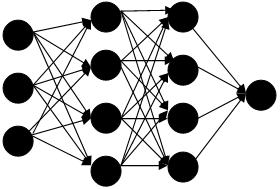
a) 0
b) 1
c) 2
d) 3
View Answer
Explanation: Hidden layers are the intermediate layer between input and output layer and it is the place where all the computation is done. From the figure the first layer of 3 nodes represents the input layer and the last layer of single node represents the output layer. Finally the two layers in between the input and output layer are known as the hidden layers which represent the activation nodes.
3. Which of the following statements is not true about the given figure?
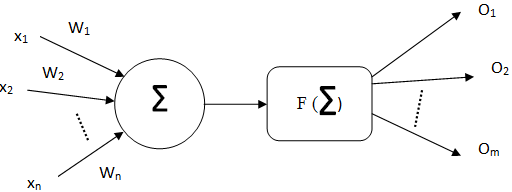
a) It shows the conceptual mathematical model of a neural network
b) It receives input from n sources
c) It computes the weighted sum as h = (w1 + x1) * (w2 + x2) * … * (wn + xn)
d) Weighted sum passes through an activation function and it sends the signal to m succeeding neurons
View Answer
Explanation: The figure shows the conceptual mathematical model of a neural network. And it receives input from n sources and computes the weighted sum as h = w1x1 + w2x2 + … + wnxn. Finally this weighted sum is passed through an activation function and it sends the signal to m succeeding neurons as shown in the figure.
4. Which of the following statements is not true about the model representation of neural networks (NN)?
a) Neural networks were developed as a way to simulate networks of neurons
b) Cell body, number of input wires, and output wire are the three important things in a NN
c) In a simple level the neuron gets one or more inputs through axon
d) After getting the input the neuron does the preprocessing and send output to axon
View Answer
Explanation: Neural networks were developed as a way to simulate networks of neurons. And cell body, number of input wires (dendrites), and output wire (axon) are the three important things to notice in a NN. So in a simple level the Neuron gets one or more inputs through dendrites, does the preprocessing and sends output to axon.
5. Which of the following statements is not true about the model representation of neurons in Neural Networks?
a) In a neural network the neuron is a logistic unit
b) The input wire does the computation
c) The input is fed via input wires
d) Output is send to output wires
View Answer
Explanation: In a neural network representation the neuron is a logistic unit and this logistic unit does the computation. In this representation the input is fed via input wires and the output is send to output wires. That logistic computation is just like the logistic regression hypothesis calculation.
6. Which of the following Boolean function is represented by the below figure, given that X1 and X2 are binary?
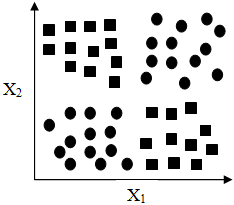
a) OR
b) AND
c) XOR
d) NOT
View Answer
Explanation: The given figure shows the non linear classification of XOR/ XNOR. Here we want to learn a non-linear decision boundary to separate the positive and negative examples represented by dark bubbles and dark squares. So, it returns negative examples when both are true and both are false. And it returns positive example when both are different.
7. Which of the following Boolean function is represented by the below figure, given that X1 and X2 are binary?
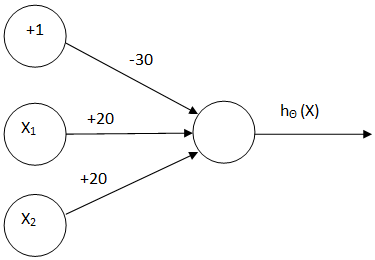
a) OR
b) AND
c) XOR
d) NOT
View Answer
Explanation: The given figure shows the AND function. Given bias B = +1, weights Θ0 = -30, Θ1 = +20 and Θ2 = +20. We have, hΘ (X) = f (BΘ0 + X1Θ1 + X2Θ2). Then for the four input values,
| X1 | X2 | hΘ(X) |
| 0 | 0 | f(1 * -30 + 0 * 20 + 0 * 20) = f(-30) ≈ 0 |
| 0 | 1 | f(1 * -30 + 0 * 20 + 1 * 20) = f(-10) ≈ 0 |
| 1 | 0 | f(1 * -30 + 1 * 20 + 0 * 20) = f(-10) ≈ 0 |
| 1 | 1 | f(1 * -30 + 1 * 20 + 1 * 20) = f(10) ≈ 1 |
So only (1, 1) gives positive output as in AND function.
8. What will be the hypotheses outputs for the below NOT function?
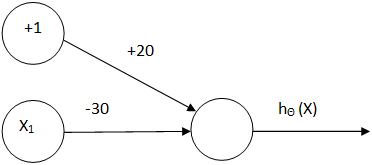
a) f (20), f (-30)
b) f (20), f (-10)
c) f (-20), f (30)
d) f (-20), f (10)
View Answer
Explanation: The given figure shows the NOT function. Given bias B = +1, weights Θ0 = +20 and Θ1 = -30. We have, hΘ (X) = f (BΘ0 + X1Θ1). Then for the two input values,
| X1 | hΘ(X) |
| 0 | f(1 * 20 + 0 * -30) = f(20) ≈ 1 |
| 1 | f(1 * 20 + 1 * -30) = f(-10) ≈ 0 |
9. Which of the following Boolean function is represented by the below figure, given that X1 and X2 are binary?
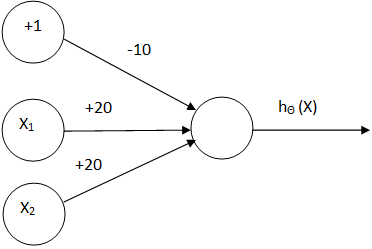
a) OR
b) AND
c) XOR
d) NOT
View Answer
Explanation: The given figure shows the OR function. Given bias B = +1, weights Θ0 = -10, Θ1 = +20 and Θ2 = +20. We have, hΘ (X) = f (BΘ0 + X1Θ1 + X2Θ2). Then for the four input values,
| X1 | X2 | hΘ(X) |
| 0 | 0 | f(1 * -10 + 0 * 20 + 0 * 20) = f(-10) ≈ 0 |
| 0 | 1 | f(1 * -10 + 0 * 20 + 1 * 20) = f(10) ≈ 0 |
| 1 | 0 | f(1 * -10 + 1 * 20 + 0 * 20) = f(10) ≈ 0 |
| 1 | 1 | f(1 * -10 + 1 * 20 + 1 * 20) = f(30) ≈ 1 |
So only (0, 0) give negative value as in OR.
Sanfoundry Global Education & Learning Series – Neural Networks.
To practice all areas of Neural Networks, here is complete set on 1000+ Multiple Choice Questions and Answers.
If you find a mistake in question / option / answer, kindly take a screenshot and email to [email protected]
